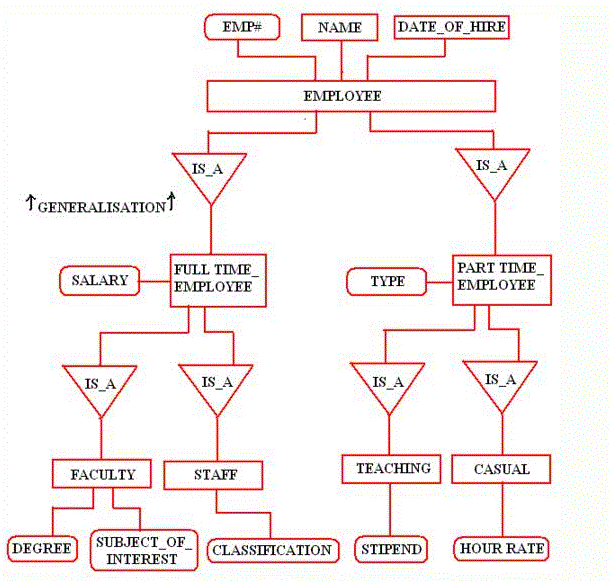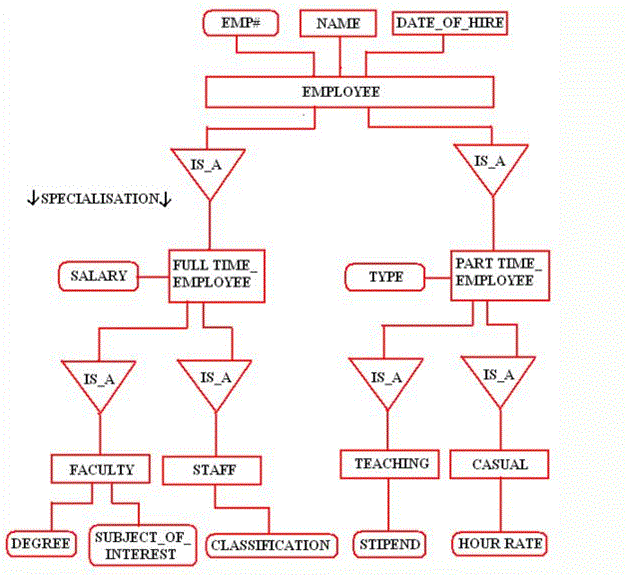Generalization, Specialization and Aggregation Concepts in DBMS
Generalization, Specialization and Aggregation in DBMS
Speculation Specialization and Aggregation in DBMS are deliberation systems used to model data. The reflection is the instrument used to shroud the unnecessary points of interest of an arrangement of articles.
For instance, vehicle is a reflection that incorporates the sort’s auto, jeep and transport.
In this way, the two deliberation instruments used to model data:
- Speculation (Specialization is the opposite procedure of Generalization)
- Collection
Generalization in DBMS
Speculation is an abstracting procedure of review sets of items as a solitary general class by focusing on the general attributes of the constituent sets while stifling or overlooking their disparities.
In basic terms, Generalization is a procedure of removing normal attributes from two or more classes and joining them into a summed up superclass. In this way, it is a base up methodology as two or lower lever substances are consolidated to shape a more elevated amount element.
The normal qualities implies here properties or techniques.
Notation of Generalization
Generalization is represented by a triangle with a line.
Generalization is an IS_A relationship
Example of Generalization:
For instance, a Part_Time Employee and Full_Time Employee element sets can be summed up as EMPLOYEE substance sets;
- The Full_Time_Employee is a speculation of the substance set Faculty and Staff;
- The Part_Time_Employee is a speculation of the substance set teaching and casual.
Bike element is not appeared as it doesn’t fulfill conditions for a subtype in light of the fact that it has every one of the credits normal to all vehicles. In this way, there are no ascribes particular to cruisers. Further, MOTORCYCLE does not have a relationship to another substance sort.
Specialization in DBMS
Specialization might be seen as the opposite procedure of Generalization. Specialization is the abstracting procedure of acquainting new qualities with a current class of items to make one or all the more new classes of articles.
In basic terms, a gathering of substances in specialization can be classified into sub-bunches in view of their attributes. So it is a top-down methodology in which one larger amount substance can be separated into two lower level element. It characterizes one or more subtypes of the supertypes and framing supertype/subtype connections.
In the above case, Faculty and Staff acquires the characteristic pay of the substance set Full_Time_Employee and last mentioned, thus acquires the properties of Employee. In this way, Faculty and Staff is a specialization of Full_Time_Employee and Full_Time_Employee is a specialization of Employee.
Additionally, Teaching and Casual acquires the quality Wage of the element set Part_Time_Employee and last mentioned, thus acquires the traits of Employee. Along these lines, Teaching and Casual is a specialization of Part_Time_Employee and Part_Time_Employee is a specialization of Employee.
Aggregation in DBMS
Conglomeration is the procedure of ordering data on an item, in this way abstracting a larger amount object. So, an element Person is inferred by amassing the qualities name, house_no., city and government managed savings number(SSN).
Another type of total says that it is abstracting a relationship in the middle of articles and survey the relationship as an item. Along these lines, in Figure below, the Enrollment relationship between substances understudy and Course element can be seen as element REGISTRATION.
In simple terms, Aggregation is a process when relation between two entities is treated as a single entity.
More Related Articles For You
- Architecture of DBMS
- CODDS RULE DBMS
- Database Models in DBMS
- Relational DBMS Concepts
- Keys and Types of keys in Database
- Database Normalization
- ERD Diagram Tutorial with Examples in DBMS
- Introduction to SQL
- How to Create Query in SQL, Create Table, Delete Table and User Insert Info Statements
- Alter Query Command in SQL, Add, Modify and Drop Column in Table
- TCL Commands in SQL
- Truncate Query, Drop and Rename Query in SQL
- All DML Statement in SQL, Select Statement, Delete, Insert and Update Statement
- Data Control Language DCL Revoke and Grant Command in SQL
- Select Statement or Select Query in SQL Explained with Examples
- Distinct Keyword Explained in SQL
- WHERE Statement or WHERE Clause in SQL Statement Explained
- AND & OR Operators in SQL
- LIKE Operator in SQL
- ORDER BY Clause Sorting Explained in SQL
- Group By Clause in SQL
- Having Clause Explained in SQL
- SQL Constraints
- SQL Aggregate Functions
- SQL Aliases Use and Purpose in SQL
- SQL Joins Types, Use and Purpose
- SQL Sequence Syntax and Use with Examples
- SQL View
- SET Operation in SQL, UNION, UNION ALL, Intersect and Minus




